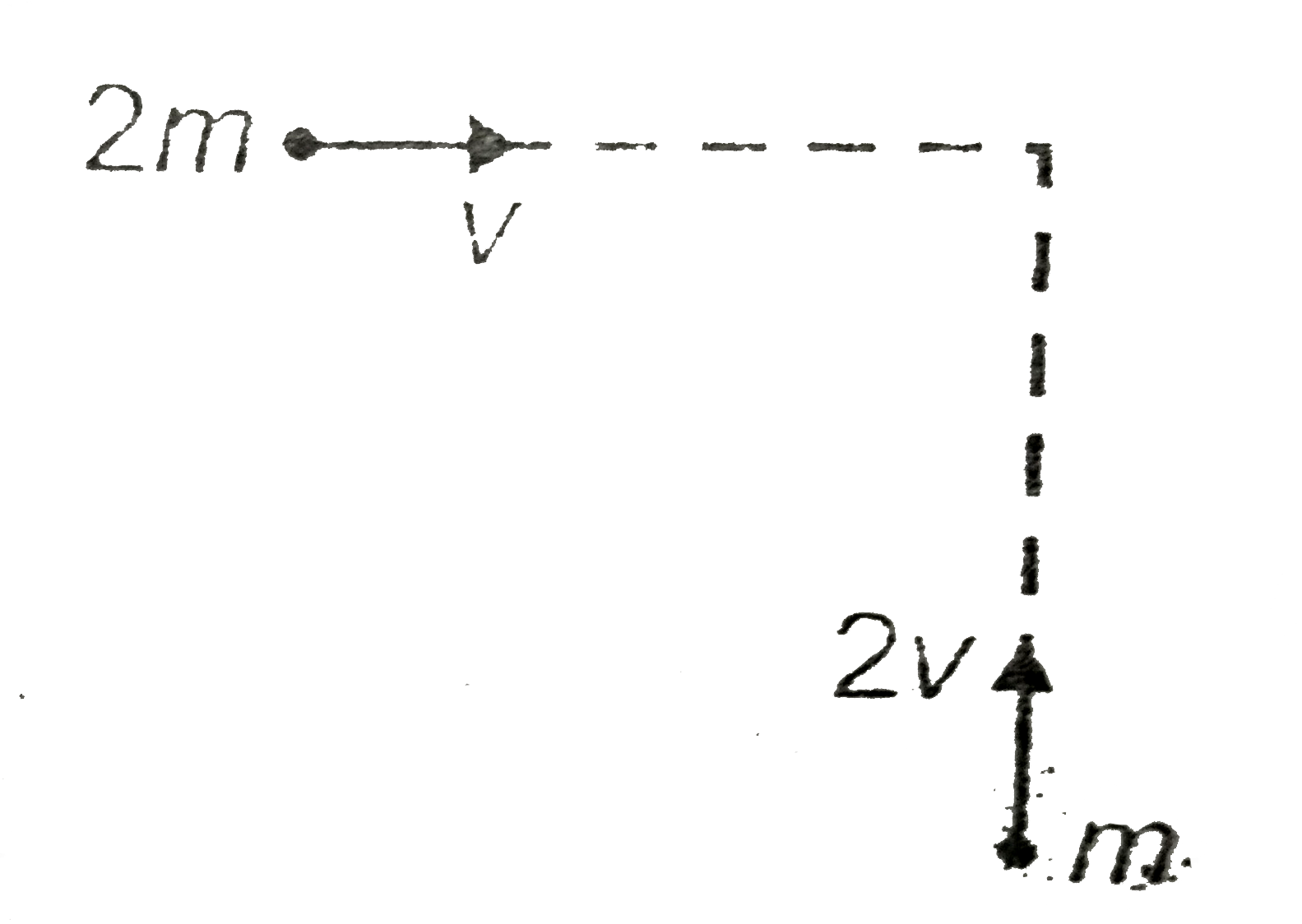Two particles of mass mA and mB and their velocities are VA and VB respectively collides. After collision they interchanges their velocities, then ratio of mAmB is
vAvB
vBvA
vA+vBvB−vA
1
The correct Answer is:D
To solve the problem of two particles colliding and interchanging their velocities, we will use the principle of conservation of momentum. Let's break down the solution step by step.
1. Define the Initial Conditions:
- Let the mass of particle A be mA and its initial velocity be VA.
- Let the mass of particle B be mB and its initial velocity be VB.
2. Write the Initial Momentum:
- The total initial momentum Pinitial before the collision is given by:
Pinitial=mAVA+mBVB
3. Define the Final Conditions:
- After the collision, the particles interchange their velocities.
- Therefore, the final velocity of particle A becomes VB and the final velocity of particle B becomes VA.
4. Write the Final Momentum:
- The total final momentum Pfinal after the collision is given by:
Pfinal=mAVB+mBVA
5. Apply Conservation of Momentum:
- According to the conservation of momentum, the initial momentum must equal the final momentum:
Pinitial=Pfinal
- This gives us the equation:
mAVA+mBVB=mAVB+mBVA
6. Rearranging the Equation:
- Rearranging the equation, we get:
mAVA−mAVB=mBVA−mBVB
- This simplifies to:
mA(VA−VB)=mB(VA−VB)
7. Factor Out the Common Term:
- If VA≠VB, we can divide both sides by (VA−VB):
mA=mB
8. Calculate the Ratio:
- Therefore, the ratio of the masses mAmB is:
mAmB=1
Final Answer:
The ratio of mAmB is 1.
- Let the mass of particle A be mA and its initial velocity be VA.
- Let the mass of particle B be mB and its initial velocity be VB.
- The total initial momentum Pinitial before the collision is given by:
Pinitial=mAVA+mBVB
- After the collision, the particles interchange their velocities.
- Therefore, the final velocity of particle A becomes VB and the final velocity of particle B becomes VA.
- The total final momentum Pfinal after the collision is given by:
Pfinal=mAVB+mBVA
- According to the conservation of momentum, the initial momentum must equal the final momentum:
Pinitial=Pfinal
- This gives us the equation:
mAVA+mBVB=mAVB+mBVA
- Rearranging the equation, we get:
mAVA−mAVB=mBVA−mBVB
- This simplifies to:
mA(VA−VB)=mB(VA−VB)
- If VA≠VB, we can divide both sides by (VA−VB):
mA=mB
- Therefore, the ratio of the masses mAmB is:
mAmB=1
The ratio of mAmB is 1.
Topper's Solved these Questions
- CENTRE OF MASSBOOK - DC PANDEYCHAPTER - CENTRE OF MASSEXERCISE - Taking it together
73 Videos
- CENTRE OF MASSBOOK - DC PANDEYCHAPTER - CENTRE OF MASSEXERCISE - Assertion and reason
21 Videos
- CENTRE OF MASSBOOK - DC PANDEYCHAPTER - CENTRE OF MASSEXERCISE - Medical entrances gallery
27 Videos
- CALORIMETRY AND HEAT TRANSFERBOOK - DC PANDEYCHAPTER - CALORIMETRY AND HEAT TRANSFEREXERCISE - Medical entrance s gallery
38 Videos
- CENTRE OF MASS, IMPULSE AND MOMENTUMBOOK - DC PANDEYCHAPTER - CENTRE OF MASS, IMPULSE AND MOMENTUMEXERCISE - Comprehension type questions
15 Videos
Similar Questions
Two identical bodies A and B moving with velocities 13 m/s and - 15 m/s respectively collide head-on elastically. What will be their velocities after collision?
View SolutionTwo particles having masses m1andm2 are moving with velocities →V1and→V2 respectively. →V0 is velocity of centre of mass of the system.
(a) Prove that the kinetic energy of the system in a reference frame attached to the centre of mass of the system is KEcm=12μV2rel. Where μ=m1m2m1+m2 and Vrel is the relative speed of the two particles.
(b) Prove that the kinetic energy of the system in ground frame is given by
KE=KEcm+12(m1+m2)V20
(c) If the two particles collide head on find the minimum kinetic energy that the system has during collision.
View Solution
Knowledge Check
Two particle of masses m and 2m are coliding elastically as given in figure. If V1 and V2 speed of particle just after collision then
_2019_CBT5_E01_051_Q01.png) AV1=11.16m/s,V2=6.31m/sBV1=10.16m/s,V2=5.31m/sCv1=9.16M/S,v2=6.31M/SDv1=6.31M/S,v2=11.16M/S
AV1=11.16m/s,V2=6.31m/sBV1=10.16m/s,V2=5.31m/sCv1=9.16M/S,v2=6.31M/SDv1=6.31M/S,v2=11.16M/STwo particles of masses m1 and m2 in projectile motion have velocities →v1 and →v2 , respectively , at time t=0. They collide at time t0. Their velocities become →v'1 and →v'2 at time 2t0 while still moving in air. The value of ∣∣∣(m1→v'1+m2→v'2)−(m1→v1+m2→v2)∣∣∣
AzeroB(m1+m2)gt0C2(m1+m2)gt0D12(m1+m2)gt0Two masses mA and mB moving with velocities vA and vB in opposite direction collide elastically after that the masses mA and mB move with velocity vB and vA respectively. The ratio (mA/mB) is
A1BvA−vBvA+vBC(mA+mB)/mADvA/vB
Two particles of mass 2m and m moving with speed v and 2v respectively pependicular to each other collides perfectly inelastically, then

Speed of the particles after collision
View SolutionA particle of mass m moving with velocity u collides elastically head on with a particle of mass 2m at rest. After collision the heavier particle moves with velocity?
View SolutionA body of mass m1 moving with a velocity 3m/s collides with another body at rest of m2 . After collision the velocities of the two bodies are 2m/s and 5m/s , respectively , along the direction of motion of m1. The ratio m1/m2 is
View SolutionIf two masses m1 and m2 collide, the ratio of change in their respective velocities is proportional to
View SolutionA particle of mass m1 moving with velocity v collides with a mass m2 at rest, then they get embedded. Just after collision, velocity of the system
View Solution
